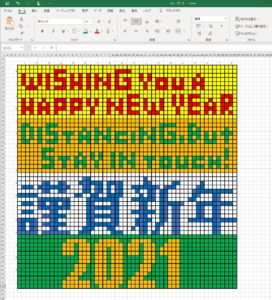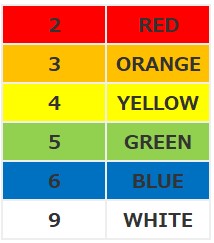Click here for printing (PDF)
Japanese version
Method for blindfolded cube art
2021/12/09
Yuichi Hamada aka Kurukuru Captain
https://kurukurukai.com
This paper describes how to complete Cube Art (aka Rubik’s art, Pixel art, Mosaic art, etc.) with a blindfold. It is not easy, but it is worth trying!
Cube Art in general
There are many attempts to draw a picture by cubes. I also enjoy this challenging art activities, some of which are listed below (Link to Youtube). These cube arts were completed without a blindfold.
| Many cubes |  |
| Many layer cube |  |
| Two face cube art |  |
| Remote cube art |  |
Example of Blindfolded Cube Art
Next, examples of Blindfolded Cube Art. These ones are the ones I am trying to explain in this paper. It is recommended you see the video (Youtube) to see how Blindfolded Cube Art is conducted.
 |
|
| QR Code |
 |
| Mona Lisa |
 |
BLINDFOLD CUBE ART and QR Code are 2 color cube art and Mona Lisa is 3 color cube art.
Draft of cube art
To avoid any misunderstanding, we are not designing the cubes while blindfolded. What I mean here by “blindfolded cube art” is the act of memorizing the preliminary design data in advance and constructing it while blindfolded.
Basically, I prepare the data for the cube art by filling in the cells of a spreadsheet software (Excel). Since I use cube art to send congratulations to acquaintances on their birthdays, anniversaries, etc. many times, I already have the bit data for fixed expressions such as [H][A][P][P][Y][ ][B][I][R][T][H][D][A][Y], etc., and can generate the data for the cube art in a relatively short time.
Also, when creating the data for a natural image, I think it is best to threshold the image after monochrome processing based on luminance (= 0.299xR + 0.587xG + 0.114xB). Empirically, thresholding a natural image with 6 steps will result in an unsightly image, so thresholding with 3 to 4 steps (3 to 4 colors) is probably realistic. I am planning to discuss this issue further in the future (not this paper).
 |
 |
 |
 |
2 color cube art blindfolded
Same as standard blindfold cube, there are memorization step and solving step. Basically, blindfold cube art does not have any competition aspects, you should use much time enough to memorize pattern.
Memorization
We utilize Binary Number Memorization Systems in memory sports. We memorize the pattern of cubes column by column, each of column is one of 23=8 patterns. There are several ways to memorize a series of these 8 patterns, such as 8 letter methods. Below is a method using Number conversion systems. At first, we convert binary to decimal.
By using Table above, convert the following pattern to decimal.
R2: [000][000][000][300][032][300]
R1: [075][507][170][757][075][500]
After the conversion, we merely memorize the series of numbers above. In cube art, there may be many repeating patterns, thus, we assign a special code to these repeating patterns to reduce the amount of memory.
Since 3 digits are required to memorize a pattern of one cube, only 90 digits are needed to reproduce 30 cube’s cube art. Top-level memory athletes may memorize 80 digits within several tens of seconds, so it is not very difficult to memorize this size of cube art pattern.
Solving step
Each cube is started starting with column M, and then columns L and R are solved after column M. This is because there are cases where column M will be corrupted if columns L and R are solved first. The procedure is shown in the table below (U face is the drawing side, F face is the candidate color side). If you are a BLD competitor, it is the same as the setup procedure, there should be no difficulty.
Since each cube is solved starting from column M, we can consider this solving order and make the memorization order as column M -> column L -> column R instead of column L -> column M -> column R.
This 2 color cube blindfolded is very simple. I expect lots of cubers try to do this new aspect of cubing.
3 color cube art blindfolded
Memorization
It is the same as 2 color art in that you memorize one column at a time, but since there are three colors, the system is trinary. We assign a number (0, 1, 2) to a particular color and memorize the sequence. There are several techniques to memorize this ternary system of numbers.
- Convert to decimal system
- Convert to alphabet
- No conversion
Converting a ternary number into a decimal number is no bargain, since the number is reduced by only one digit, from three to two. If you are using alphabetic memory, you can assign an alphabet (although one is missing) to each of the 27 patterns.
Assuming that drawing plane 0 is the U face (blue), candidate color plane 1 is the F face (red), and candidate color plane 2 is the B face (orange), the following pattern (the eye of the Mona Lisa) can be converted to a trigram as follows:
R2:[(211)(210)(210)][(221)(222)(221)][(211)(210)(210)][(210)(210)(101)][(111)(001)(000)]
R1:[(122)(122)(122)][(122)(111)(222)][(122)(122)(122)][(122)(122)(122)][(221)(111)(000)]
If we convert this to decimal (L fixed, M/R converted), we get the following:
R2:[(22)(21)(21)][(25)(26)(25)][(22)(21)(21)][(21)(21)(10)][(13)(01)(00)]
R1:[(17)(17)(17)][(17)(26)(13)] [(17)(17)(17)][(17)(17)(17)][(25)(13)(00)]
In the case of 2 color cube art, a single cube is a three-digit number, but in the case of 3 color cube art, a single cube is a six-digit number. I think it is possible to do image processing in the brain and use run length Encoding (RLE) to reduce the amount of memory.
Solving step
Now it’s time to solve.
Solve from column M as in the 2 color cube art. It is basically the same as the BLD setup. In the case of three colors in a column (012 or 120), it is like solving the center first, then the edges (UF/UB).
Next is the L/R column.
First, solve the edges (UR or UL). Basically, use the U-palm (z’y or z’y’, which needs to be set up). The “*” in the following table is a wildcard, and the color should not change before and after solving.
If the edges of columns L and R do not interfere with each other, i.e.
- In columns L and R, when the order of solving is later
- In columns L and R, the order of solving is first, but the edges of the later columns are not moved.
In the above cases, a simple operation is also acceptable ((easy) procedure in the table above).
Next is the corner of L/R column.
In the table, “1*2” is R palm and “2*1” is OLL45, but you can turn it in any way you like.
If you can understand the theory of 3 color cube art, you should be able to perform the four- to six-color cube art shown below. Let’s master the 3 color cube art first!
4 color cube art
Four-color cube art uses the D face in addition to the three-color cube art (F face, U face, and B face). If the color of the D face is included at the time of memory, then in the brain:
- Perform L2, M2, or R2
- Consider the color of D face as the color of U face
- Switch the color of F face and B face
- Memorize
If we were to memorize in decimal format, the memory table would look like the following. The solving is the same as for the 3 color cube art, so I will skip it.
5/6 color cube art
If you are familiar with the theory of 3 color/4 color cube art, you can easily extend it to 5 color/6 color cube art. y or y’ can be used to change the color of L or R face to U face. The basic order of execution is “Center -> M column edge -> L/R column edge -> L/R column corner”. If you do not make a mistake, you should be able to reproduce this except for special cases (Unfortunately, some patterns can only be handled individually, so we will skip them this time.)
Also, with six colors, I don’t think there is any need for conversion to reduce the number of digits. Instead, the problem would be how to map the colors to the numbers. I think that color coding of resistors would be a good idea.
Finally
Below are some notes for blindfolded cube art:
- I guess “Blindfolded Cube Art” is short for “BLDART”.
- It is an art form, so a few mistakes in memory or solving are acceptable. It’s also interesting to see how many different people try the same Mona Lisa design with blindfolded cubes and enjoy the variations.
- One of the drawbacks of memory sports is that it is difficult to know the progress of the competition. One way to solve this problem is to make the blindfolded cube art a competition. For example, I think it would be well received by the general public if it were a competition for quick memorization and quick matching of QR codes (e.g. a separate competition were held for the strength of error correction in the recognition algorithm).
- I have more than 300 of 56mm cubes and 1000 of 30mm mini cubes at home, so when I have time, I want to do a giant cube art blindfolded…















コメント